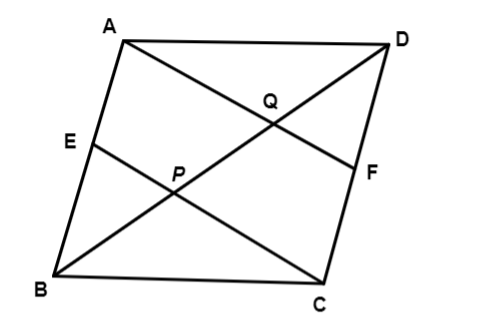
Answer
377.4k+ views
Hint: In this problem, \[ABCD\] is a parallelogram and the midpoint also given in the diagrammatic representation, Parallelogram is defined as a quadrilateral in which both pairs of opposite sides are parallel is called a parallelogram. Here, we use the conversion of the midpoint theorem, the line drawn through the midpoint of one side of a triangle, parallel to another side bisecting the third side.
Complete step-by-step answer:
In the given problem,
\[ABCD\] is a parallelogram. \[E\] and \[F\] are the mid-points of sides \[AB\] and \[CD\] respectively.
To show: line segments \[AF\] and \[\;EC\] trisect the diagonal \[BD\] .
Proof,
\[ABCD\] is a parallelogram
Therefore, \[AB\parallel CD\]
also, \[AE\parallel FC\]
Now,
\[AB{\text{ }} = {\text{ }}CD\]
(Opposite sides of parallelogram \[ABCD\] )
\[\dfrac{1}{2}{\text{ }}AB = \dfrac{1}{2}CD\]
\[AE = FC\]
Where, \[E\] and \[F\] are midpoints of side \[\;AB\] and \[CD\] .
Since a pair of opposite sides of a quadrilateral \[\;AECF\] is equal and parallel.
so, \[\;AECF\] is a parallelogram
Then, \[AE\parallel EC\] ,
\[AP\parallel EQ\] and \[FP\parallel CQ\]
Since, opposite sides of a parallelogram are parallel
Now,
In \[\Delta DQC,\]
\[F\] is midpoint of side \[DC\] and \[FP\parallel CQ\]
(as \[AF\parallel EC\] ).
So, \[P\] is the midpoint of \[DQ\]
Here, we use converse of midpoint theorem, we get
\[DP = PQ{\text{ }} \to {\text{(1)}}\]
Similarly,
In \[APB,\]
\[E\] is the midpoint of side \[AB\] and \[EQ\parallel AP\] (as \[AF\parallel EC\] ).
So, \[Q\] is the midpoint of \[PB\] .
By applying Converse of midpoint theorem, we get
\[\;PQ = QB \to (2){\text{ }}\]
From equations \[(1)\] and \[(2)\] , we get
\[DP = PQ = BQ\]
Hence, the line segments \[AF\] and \[EC\] trisect the diagonal \[BD\] .
Note: Here, we have to solve the geometric problem by the diagrammatic representation and here, a parallelogram concept is used and a converse of the midpoint theorem is used. A quadrilateral is a parallelogram if Its opposite sides are equal, its opposite angles are equal, diagonals bisect each other and a pair of opposite sides is equal and parallel.
Complete step-by-step answer:
In the given problem,
\[ABCD\] is a parallelogram. \[E\] and \[F\] are the mid-points of sides \[AB\] and \[CD\] respectively.
To show: line segments \[AF\] and \[\;EC\] trisect the diagonal \[BD\] .
Proof,
\[ABCD\] is a parallelogram
Therefore, \[AB\parallel CD\]
also, \[AE\parallel FC\]
Now,
\[AB{\text{ }} = {\text{ }}CD\]
(Opposite sides of parallelogram \[ABCD\] )
\[\dfrac{1}{2}{\text{ }}AB = \dfrac{1}{2}CD\]
\[AE = FC\]
Where, \[E\] and \[F\] are midpoints of side \[\;AB\] and \[CD\] .
Since a pair of opposite sides of a quadrilateral \[\;AECF\] is equal and parallel.
so, \[\;AECF\] is a parallelogram
Then, \[AE\parallel EC\] ,
\[AP\parallel EQ\] and \[FP\parallel CQ\]
Since, opposite sides of a parallelogram are parallel
Now,
In \[\Delta DQC,\]
\[F\] is midpoint of side \[DC\] and \[FP\parallel CQ\]
(as \[AF\parallel EC\] ).
So, \[P\] is the midpoint of \[DQ\]
Here, we use converse of midpoint theorem, we get
\[DP = PQ{\text{ }} \to {\text{(1)}}\]
Similarly,
In \[APB,\]
\[E\] is the midpoint of side \[AB\] and \[EQ\parallel AP\] (as \[AF\parallel EC\] ).
So, \[Q\] is the midpoint of \[PB\] .
By applying Converse of midpoint theorem, we get
\[\;PQ = QB \to (2){\text{ }}\]
From equations \[(1)\] and \[(2)\] , we get
\[DP = PQ = BQ\]
Hence, the line segments \[AF\] and \[EC\] trisect the diagonal \[BD\] .
Note: Here, we have to solve the geometric problem by the diagrammatic representation and here, a parallelogram concept is used and a converse of the midpoint theorem is used. A quadrilateral is a parallelogram if Its opposite sides are equal, its opposite angles are equal, diagonals bisect each other and a pair of opposite sides is equal and parallel.
Recently Updated Pages
How many sigma and pi bonds are present in HCequiv class 11 chemistry CBSE

Mark and label the given geoinformation on the outline class 11 social science CBSE

When people say No pun intended what does that mea class 8 english CBSE

Name the states which share their boundary with Indias class 9 social science CBSE

Give an account of the Northern Plains of India class 9 social science CBSE

Change the following sentences into negative and interrogative class 10 english CBSE

Trending doubts
Fill the blanks with the suitable prepositions 1 The class 9 english CBSE

The Equation xxx + 2 is Satisfied when x is Equal to Class 10 Maths

In Indian rupees 1 trillion is equal to how many c class 8 maths CBSE

Which are the Top 10 Largest Countries of the World?

How do you graph the function fx 4x class 9 maths CBSE

Give 10 examples for herbs , shrubs , climbers , creepers

Difference Between Plant Cell and Animal Cell

Difference between Prokaryotic cell and Eukaryotic class 11 biology CBSE

Why is there a time difference of about 5 hours between class 10 social science CBSE




